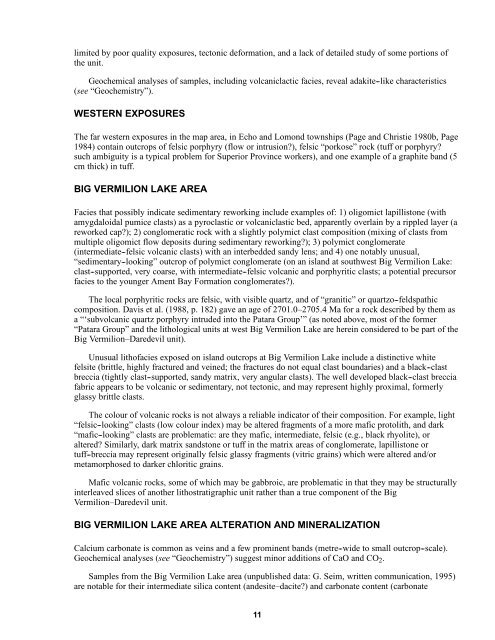Regional Geology, Sioux Lookout Orogenic Belt - Geology Ontario
Regional Geology, Sioux Lookout Orogenic Belt - Geology Ontario
Regional Geology, Sioux Lookout Orogenic Belt - Geology Ontario
Create successful ePaper yourself
Turn your PDF publications into a flip-book with our unique Google optimized e-Paper software.
limited by poor quality exposures, tectonic deformation, and a lack of detailed study of some portions of<br />
the unit.<br />
Geochemical analyses of samples, including volcaniclactic facies, reveal adakite--like characteristics<br />
(see “Geochemistry”).<br />
WESTERN EXPOSURES<br />
The far western exposures in the map area, in Echo and Lomond townships (Page and Christie 1980b, Page<br />
1984) contain outcrops of felsic porphyry (flow or intrusion?), felsic “porkose” rock (tuff or porphyry?<br />
such ambiguity is a typical problem for Superior Province workers), and one example of a graphite band (5<br />
cm thick) in tuff.<br />
BIG VERMILION LAKE AREA<br />
Facies that possibly indicate sedimentary reworking include examples of: 1) oligomict lapillistone (with<br />
amygdaloidal pumice clasts) as a pyroclastic or volcaniclastic bed, apparently overlain by a rippled layer (a<br />
reworked cap?); 2) conglomeratic rock with a slightly polymict clast composition (mixing of clasts from<br />
multiple oligomict flow deposits during sedimentary reworking?); 3) polymict conglomerate<br />
(intermediate--felsic volcanic clasts) with an interbedded sandy lens; and 4) one notably unusual,<br />
“sedimentary--looking” outcrop of polymict conglomerate (on an island at southwest Big Vermilion Lake:<br />
clast--supported, very coarse, with intermediate--felsic volcanic and porphyritic clasts; a potential precursor<br />
facies to the younger Ament Bay Formation conglomerates?).<br />
The local porphyritic rocks are felsic, with visible quartz, and of “granitic” or quartzo--feldspathic<br />
composition. Davis et al. (1988, p. 182) gave an age of 2701.0–2705.4 Ma for a rock described by them as<br />
a “‘subvolcanic quartz porphyry intruded into the Patara Group’” (as noted above, most of the former<br />
“Patara Group” and the lithological units at west Big Vermilion Lake are herein considered to be part of the<br />
Big Vermilion–Daredevil unit).<br />
Unusual lithofacies exposed on island outcrops at Big Vermilion Lake include a distinctive white<br />
felsite (brittle, highly fractured and veined; the fractures do not equal clast boundaries) and a black--clast<br />
breccia (tightly clast--supported, sandy matrix, very angular clasts). The well developed black--clast breccia<br />
fabric appears to be volcanic or sedimentary, not tectonic, and may represent highly proximal, formerly<br />
glassy brittle clasts.<br />
The colour of volcanic rocks is not always a reliable indicator of their composition. For example, light<br />
“felsic--looking” clasts (low colour index) may be altered fragments of a more mafic protolith, and dark<br />
“mafic--looking” clasts are problematic: are they mafic, intermediate, felsic (e.g., black rhyolite), or<br />
altered? Similarly, dark matrix sandstone or tuff in the matrix areas of conglomerate, lapillistone or<br />
tuff--breccia may represent originally felsic glassy fragments (vitric grains) which were altered and/or<br />
metamorphosed to darker chloritic grains.<br />
Mafic volcanic rocks, some of which may be gabbroic, are problematic in that they may be structurally<br />
interleaved slices of another lithostratigraphic unit rather than a true component of the Big<br />
Vermilion–Daredevil unit.<br />
BIG VERMILION LAKE AREA ALTERATION AND MINERALIZATION<br />
Calcium carbonate is common as veins and a few prominent bands (metre--wide to small outcrop--scale).<br />
Geochemical analyses (see “Geochemistry”) suggest minor additions of CaO and CO 2 .<br />
Samples from the Big Vermilion Lake area (unpublished data: G. Seim, written communication, 1995)<br />
are notable for their intermediate silica content (andesite–dacite?) and carbonate content (carbonate<br />
11

















